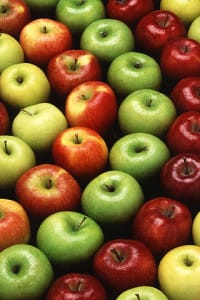A public health expert explains how Environmental Working Group identifies the cleanest—and dirtiest—produce you’re eating.
Rodale News
by Leah Zerbe
 |
If you haven’t seen the 2014 Dirty Dozen list yet, it’s a must read. In a matter of minutes, you’ll be armed with shopping power that can help protect your family from toxic, IQ-lowering chemicals.
What you don’t directly see when you dive into the handy, easy-to-understand report are the months of work analysts at the nonprofit Environmental Working Group
Rodale News caught up with Sonya Lunder, MPH, senior analyst at EWG (and one of the masterminds behind the report), to learn more about how EWG comes up with its annual Dirty Dozen list.
Rodale News: Why is a nonprofit group like Environmental Working Group releasing a report on pesticide levels on food? Doesn’t the government already do that?
Sonya Lunder: EWG researchers analyze an extensive database of testing results released by U.S. Department of Agriculture and the Federal Food and Drug Administration to bring attention to pesticide residues on popular fruits and vegetables, and to help consumers make informed decisions about the foods they eat and feed to their families.
EWG’s Shopper’s Guide to Pesticides in Produce is designed to step in where the government falters. It translates comprehensive data into a user-friendly tool that empowers Americans to reduce their exposures to pesticides in their diet.
How do you determine the “Dirty Dozen” and “Clean 15” lists? What criteria do you look at?
SL: EWG’s Shopper’s Guide is based on an analysis of pesticide residues measured on produce by USDA and FDA. The USDA doesn’t test every food every year, so EWG researchers use the most recent sampling period for each food.
Nearly all the tests that serve as the basis for the Guide were conducted by the USDA, whose personnel washed or peeled produce prior to testing them. In order to compare foods, EWG looked at six measures of pesticide contamination including percent of samples tested with detectable pesticides and average number of pesticides found on a single sample. More on EWG’s methodology can be found here.
What are some of the most common and some of the most concerning pesticide residues you’re routinely finding on food?
SL: In general, the most concerning pesticides in use are those used to kill insects. Several long-term studies have found that American children with higher exposure to insecticides have lower IQs and other signs of brain and nervous system impairment.
The U.S. Environmental Protection Agency has ended the use of some pesticides on some foods, but EWG believes further restrictions are necessary. In addition to our 2014 Dirty Dozen list, we have added hot peppers and leafy greens—kale and collard greens—as crops with toxic pesticide residues on them.
The most common pesticides found on produce are those applied after crops are harvested. These include pest treatments that kill mold and prolong produce storage.
Why do you think nonorganic apples have topped your list of most pesticide-laden produce for four years straight?
SL: Apples are heavily treated with pesticides. The average apple has five pesticides detected on it. This year EWG reported that a common, post-harvest pesticide called diphenylamine, or DPA, was detected on more than 80 percent of raw apples in 2010, the most recent year they were tested.
DPA has been banned in Europe because of concerns it could break down to form nitrosamines, chemicals known to cause cancer. In the U.S., there appears to be no plans to reconsider DPA or mandate that the companies who make and use it prove that it is safe.
Why isn’t washing produce enough? Do certain types of pesticides actually get inside of food?
SL: Washing and peeling conventional fruits and vegetables will not remove all of the pesticide residues. The government data used to create EWG’s Shopper’s Guide is from produce tested as it is typically eaten. This means the pesticide residues were detected after the fruits and vegetables were washed and peeled (when applicable). Some types of pesticides are taken up into the fruit or vegetable itself. It is a reasonable assumption that unwashed produce would likely have higher concentrations of pesticide residues.
The pesticide residue levels are small, right? So can tiny doses like these actually impact our health in negative ways? Could you give a few examples of how this might be happening?
SL: Most of the pesticide residues found on the tested produce are below the tolerance levels set by the federal government. However, it only means the pesticide residue levels are within legal limits. It does not mean they are safe. The tolerance levels are set so high that it’s very difficult for growers to violate them. EWG believes many should be lowered.
What are your top recommendations for people on a shoestring budget who want to avoid pesticides?
SL: EWG understands that organic produce is not accessible or affordable for everyone, so that’s why EWG researchers create and publish the annual Shopper’s Guide to Pesticides in Produce.
EWG recommends consumers shop for the items on the Clean Fifteen to reduce their exposure to pesticides in their diet. Shop in-season and don’t buy more than you need. Food waste is a big contributor to greenhouse gas production and a drag on your wallet.

